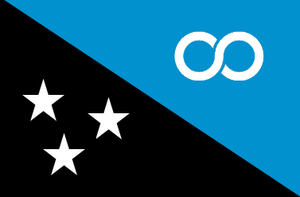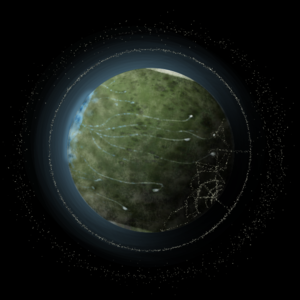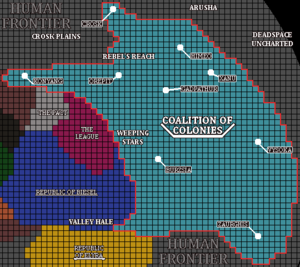Coalition of Colonies
The Coalition of Colonies is an independent, space-faring nation formed of once-Solarian colonies residing in the frontier. Population estimates range from 85 to 110 billion, with an accurate census being nearly impossible due to the decentralized government of the Coalition. Founded in a revolt against the governance of the Association of Sovereign Solarian Nations, or the Sol Alliance, it won its independence in the prolonged Interstellar War. It is made up of 357 core member systems with a fluctuating number of loosely-defined associated systems. Previously known as the Frontier Alliance, the Coalition is one of the most diverse entities in known space culturally, socially, and politically.
Government
The overarching government of the Coalition is a confederation held together by the Frontier Alliance Defense Pact, a treaty which ensures that all members will come to the aid of the other in a case of invasion or in more recent times, to defend against piracy. It is headed by the Chief Representative, the representative of whatever planet is voted as the capital of the Coalition. The current Chief Representative is Reilly Sianne of Xanu Prime.
The government of each individual entity within the Alliance varies dramatically, from republics to monarchies to communist parties, but the entities all agree to have representatives meet on the capital planet. This bi-annual meeting, known as the Representative Summit, forms the leadership of the Coalition of Colonies. The Representative Summit is a bicameral legislature, made up of by the House of Members and the House of Observers.
The House of Members is formed of the core systems of the Coalition, and is where legislation can be proposed. The House of Observers is formed of representatives from affiliated frontier systems. While the House of Members currently has 357 members, because of the state of the wild frontier attendance for the Observer house can range from as few as fifty up to five hundred. Each system receives one representative. There is only one written rule to the Summit - no violence may take place in the chambers. All other rules and regulations are merely agreed upon traditions, solidified over the Coalition's history. The Coalition of Colonies does not care how each system governs themselves, they only ask that each system respect one another and honor the pacts during the time of a crisis.
Notable Members
Xanu Prime
The Xanu Free League, located in the system of Xanu, is the current capital of the Coalition. Megacities dot the surface of Xanu Prime, with only a small rural population. The League is governed by a president who is elected from among the mayors of the megacities and serves a three year term. In the capital city of Argia sa Mar, many embassies and legations are found in the Foreign Quarter, alongside branch offices of every megacorporation. The low-lying grasslands and beaches outside the towering metropolises are coated in craters, rusting military equipment, and graves from the Siege of Xansan during the Interstellar War, one of the most brutal battles of the conflict. These areas are protected by the government against looting and desecration as a massive memorial covering 93 percent of the planet. The government of the Coalition, the Representative Summit, meets on the artificial island of Greentree, located equidistant from every city on the planet.
Himeo
Himeo (Hephaestus Industries Mineral Extraction Operation) is an economic powerhouse of the Frontier Alliance originally founded as a mineral extraction operation by Hephaestus Industries in the 2200s. The planet openly revolted in the years leading up to the Interstellar War, and joined hands with Xanu in the formation of the original Coalition of Colonies. It has one of the most accurate censuses on the frontier due to its strong government: its 2460 population stands at 1.5 billion citizens on the planet itself with 200 million in orbit. Presently, Himeo serves as a primary source of raw materials for the Coalition due to its location near Xanu and large underground deposits of metals. Himeo is a barren, permafrost world where most of the population lives in four major cities and one large offworld station: Magnitogorsk (the largest settlement on the planet), Highland City (the major spaceport), Cannington (a major industrial center), Kiruna (the center of government), and Danzig Station in orbit.
The surface of Himeo is defined by its large, windswept plains broken up by massive mountain ranges. The average temperature is generally −58.2 °C (−72.8 °F) before factoring in wind chill, so all major settlements are built into the ground - with the largest cities extending kilometers under the ground. Himeo is a direct democracy, with its First Speaker being elected by a pure majority vote every five years. Unlike many planets on the frontier, Himeo operates a small standing fleet of formerly corporate vessels, self-made warships, and Interstellar War prize ships. Megacorporations are banned from operating in Himeo’s space.
Zaurghis
Zaurghis is an unremarkable planet in an equally unremarkable star system roughly forty light years from Xanu. The planet itself is small, relatively similar to Earth, and devoid of most materials early colonists sought after. Zaurghis is, however, in an ideal location to exploit a feature unique to the frontier: wormhole travel. Zaurghis’s system is, through sheer luck or unknown forces, home to dozens (if not hundreds) of wormholes: some consistently stable, some changing by the hour. The economy of Zaurghis was, for the better part of its existence, centered around these wormholes: the planet had a booming shipping industry, with most of it concentrated in low-orbit docks. There was, of course, some illegal activity. However, a robust system of enforcement and policing kept the Zaurghis wormholes mostly free of danger.
With the end of Solarian rule during the Interstellar War, there was no real push for government on the planet by the majority of the population, with the small amount of those who did, most of them being the original residents of the planet, exiled to its moon, Visraho. Previously a penal moon known as Correctional Facility 48, now there exists a small pro-corporate society. Over time, an anarchist society developed, lacking official law or representation: a society run purely by the idea of the Non-Aggression Principle, or NAP. Citizenship is automatically granted to all owners of property above one acre in size, and these citizens directly vote for their representation in the Coalition.
However, with the recent proliferation of bluespace technology, Zaurghis’ wormholes have seen less and less use by merchants. Private enterprises have developed the once-prominent business port into one of the largest parts of the Coalition’s shipbuilding sector. Alongside this, however, a new area of commerce has emerged: smugglers, always willing to take risks in order to avoid authorities, have taken to utilizing the wormholes around Zaurghis in order to ship product. These smugglers tend to avoid the larger and more well-traveled wormholes, instead risking life and limb on the smaller and less predictable, but less policed, wormholes. With smuggling being fully permitted on the planet, many have come to call this relatively inoffensive planet home.
Gadpathur
Located in the Weeping Stars, the former Alliance Neutral Zone, is Gadpathur: a planet-sized reminder of the bloody fighting of the Interstellar War. Prior to the retreat of the Solarian Alliance from its Outer Ring, the grim people of Gadpathur were regarded as the Coalition's first line of defense against Solarian imperialism in the event of a Second Interstellar War. Now with the Alliance in retreat, the future of the planet might take a quite different turn. The primary language of Gadpathur is Gadpathurian Common, a dialect of Solarian Common dating back to before the Interstellar War.
Assunzione
Located in Light's Edge, on the ragged edge of the Coalition of Colonies, lies the Republic of Assunzione. While it did not participate in the bloody fighting of the Interstellar War, the Republic's position led it join the Coalition following the end of the War. Despite not having a functional star Assunzione is the largest settlement in Light's End and is known for being the gateway into the sector. It is also home to its own religion, Luceism. The primary language of Assunzione, unlike the rest of the Coalition, is Assunzionii Tradeband.
Vysoka
The Free System of Vysoka is the agricultural center of the Coalition of Colonies, commonly known as the “Breadbasket of the Frontier” due to a large number of foodstuffs exported from the planet. The main language of Vysoka is Freespeak, though Tradeband is commonly spoken among merchants. The colony of Vysoka is located in the Zeic system.
Crosk
Located in the Astoral system, the hot and arid planet of Crosk is a sparsely-populated mining world that has risen to punch above its weight due to its massive aviation industry. Crosk has become renowned throughout the Orion Spur due to the thriving racing scene that has developed as a result of this racing industry. Crosk has a remarkably high concentration of IPCs, which have come to prominence in the racing scene due to their superior reflexes compared to organic pilots. IPCs are so prominent that they have their own synthetic racing league, due to their superior reflexes. The planet is regarded colony of Xanu Prime, which sent the first settlers to its rich mineral fields in 2395, and maintains a close relationship with it.
Konyang
The former Solarian world of Konyang is one of many areas that changed hands in the chaotic aftermath of the events of the Solarian Collapse seen in KING OF THE WORLD. Originally established in 2305 as a water-rich planet, Konyang's claim to fame has long been its status as the birthplace of modern robotics thanks to the discovery of drones on its surface. Even before defecting from the Sol Alliance Konyang had a very friendly relationship with the Coalition, which has made it the arguably most important former Solarian world in the Coalition - though Gadpathur remains suspicious of it. A significant IPC population can be found on Konyang, due to the planet's massive robotics industry and citizenship rights.
Scarabs
The Scarabs are a tightly-knit and primarily nomadic faction which resides upon gargantuan home-fleets. Seen as a hardy and self-sufficient people, their primary fleet holds the structure of a uniquely made Khaganate. Led by the young Iraiya, the Queen in Blue is the perpetually mobile fleet. Many Scarabs are seen planet-side in unclaimed territory, making usage of untapped materials or valuable sources of food and water to supply the ever-growing fleet as it moves. The Scarabs meet criticism for what is essentially a conquest through uncharted territory surrounding the space of the Sol Alliance. Though at this point, it's clear they have no reason or will to care.
The Scarabs seek to unify Humanity under one banner at any cost, or so Iraiya says. Their intent at the least to absorb all Offworlders into their own home fleets is clear, and they have found little difficulty in convincing many to join them, using safety and plentiful supplies as prime motivators, though some warn their actions will eventually wake the slumbering Sol Alliance…
Society
While every species can be found in the Coalition, it is human dominated due to its origin as part of human colonization efforts. However, the exact breakdown of Coalition society being impossible to determine. Social organization can vary wildly from planet to planet: the Coalition is home to a variety of states ranging corporate oligarchies, industrial wastes, militarized states, popular republics, and authoritarian regimes unified by the Frontier Alliance Defense Pact.
The Frontier Protection Bureau (FPB)
Though the military composition of the greater Coalition of Colonies is rather complex, with separate system states operating different levels of navy and ground assets, the Frontier Protection Bureau has remained a staple of not only the Coalition government, but through the Frontier Rangers, also of the entire human frontier in general. The origins of the movement were out of sheer necessity, formed unofficially by members of the Frontier Alliance to combat the various threats early colonies had faced in the untamed regions they inhabited. Alone many colonies lacked the supplies, training, and sheer manpower to effectively handle threats such as carp migrations and pirate attacks. In the sprawling attempts to fight these issues together, the Frontiersmen culture emerged, a rather wide ideology centred on personal freedoms, and the struggle to keep to them against overbearing odds. While these initial men and women would romantically refer to themselves as the Legion of Frontiersmen, their name and reputation would hold much more weight following the Interstellar War. There, countless Rangers would participate as a paramilitary unit, used in various guerilla warfare missions which would forge their legend for years to come. It had also solidified the Frontier Rangers as a force not meant to serve any one nation, but the Coalition and its eternal freedom as a whole.
Included in the Frontier Alliance Defense Pact was the establishment of an officially recognized intelligence office to help carry out the will of the Alliance. Already known by much of the Coalition and even outside of it, the Rangers were easily merged with several semi-official agencies to create the Frontier Protection Bureau. Both halves of the organisation are headed by the Chief Marshal who is themselves nominated by the office of the Chief Representative, and then voted in by the House of Members. While the Bureau’s intelligence service is given directives by the Chief Representative as well, the rest of the organization - most importantly, the Frontier Rangers Division - is held accountable by the House of Members, who may question and overrule actions taken by the force if a consensus is reached. Due to this, Rangers are generally not allowed to interfere with local governments (unless explicitly asked to by said administrations), and the extent of their operations have mostly been the same as in their past. While securing the ever-changing borders of the Frontier from pirates, spacefaring creatures and other unusual threats is a constant worry, the rest of the Bureau is otherwise employed in various intelligence operations, the nature of which only the Chief Representatives and their selected Marshals of the past and present have been privy to. Numerous theories abound, as the lack of any overseeing agency holding the group accountable makes it particularly difficult to ascertain how far some operations have gone, a fact that the CFP has denounced multiple times. While some continue to push for the Bureau to have the reach it needs to establish stability, others warn against the creation of a police force that could unwind the very ideals the Coalition was built upon. The Rangers themselves are indeed not spared from political infighting, and many within their ranks struggle to internalize whether they are a symbol of the grand ideals of the Coalition, or a possible tool for those who wish to see the Frontier quelled.
Internally, the FSB is supplied through a quota expected of every core member, scaled depending on a system’s individual military capacity. This may include everything from weaponry and manpower to ships and building materials. While this would make the Bureau one of the most well-funded forces in the galaxy by numbers, in reality, the sheer size of the Coalition means that the average Ranger or agent sees very little of this money, and often ends up relying on either outdated or faulty equipment. Many operations only continue to persist due to the zealous nature in which many operators adhere to their Frontiersman traditions, managing to scrape by with not much support. For similar reasons, the selection process for agents is often aimed at finding volunteers that are particularly committed to upholding the Coalition’s values, which further serves to reinforce the stereotypes which plague the position. More specifically, Rangers are often chosen from already established sub-groups within their nation of origin, such as particularly well-performing Gadpathurian cadres or Vysokan Host-men eager for adventure outside of their Steppes. While much more unusual, Scarab Rangers have been well-respected in the past for their self-sufficient lifestyle and effectiveness in Zero-G conditions, which encompass much of a Ranger’s work. Though primarily composed of humans, there have been notable Rangers of various species, such as Himean Tajara, who are often employed in missions which cater to their highly specialized skill set.
Synthetics in the Coalition
The Coalition of Colonies is well known for its diverse collection of governments, cultures and beliefs, and the treatment of synthetics across the Coalition is similarly diverse. From the highly integrated, forward-thinking planet of Konyang to the oppressive methods used on Burzsia, many other planets fall between these extremes, and the prospects of synthetics vary greatly depending on where they are located. The majority of synthetics in the coalition are owned by mega-corporations or other private entities, with free IPC frames making up a smaller minority of those across the Coalition. The synthetic population of the Coalition is also centralized into the more developed planets present within the coalition, due to their requirements for charging and maintenance to be regularly available to them, positronics on more rural, less developed worlds are either exceedingly rare or not present at all.
The legal status of synthetics within the Coalition is mostly down to the local laws of the planet where they find themselves residing, either by choice or through ownership. These matters are left to the local governments across the coalition and so their treatment often comes down to who owns them or the personal wealth they can accrue.
The Golden Deep and The Trinary Perfection both have a presence across the Coalition as well, with the Golden Deep operating across many of the planets and the Trinary Perfection making use of its base on Orepit to preach and perform its work within the Coalition itself, both groups hold decent influence over various parts of the Coalition.










